Acosta’s Experience Helps Prospective Students and Leads to College 101 Workshop Series

As a first-generation college student, Financial Aid and Admissions Counselor Romer Acosta didn’t know what resources were available to him while applying to schools. At Arcadia, he’s working to ensure prospective students know the scholarships and resources available to them.
An early high school graduate—only 16 at the time—Acosta applied to seven schools and found that his first choice was out of his price range. Looking back, while he’s glad that he went to Temple University, he wishes he’d known some of the enrollment resources that he knows now.
“I always define myself as very adaptable and open to change,” said Acosta, who moved to New York City at the age of 12 from the Dominican Republic, before moving to Philadelphia as a junior in high school. “My journey has been about adapting and using my skills where I’ve been needed. [When it came to college] I had a list of schools I applied to, but I didn’t know much about how to go about it. So, knowing what I went through and what I know now, I try to share that experience with students.”
As a child, Acosta was enrolled in primary school at just 3-years-old, enabling him to jump ahead to high school when he moved to the U.S. He earned a bachelor’s degree in Business Administration—after changing majors four times—at 20 and enrolled at Temple as a graduate student. At 22, he graduated with his Master of Education, specializing in Adult and Organizational Development.
“I went from relying on my parents to being on my own at 16,” said Acosta. “I’m that type of person where I know change is inevitable, and that was my entire college career.”
As part of his high school coverage areas, Acosta works with some students in the Philadelphia area, including his alma mater Olney Charter High School, where he graduated as valedictorian. He said his ultimate goal is to ensure students are successful, even if it means having hard conversations about the cost of higher education and the size of the schools.
“I talk to families like how I wish someone had spoken to me before I made the decision,” said Acosta, who wishes someone had addressed with him how big classes can be at Temple. He recalls walking into his first lecture, which had hundreds of students in it. “I want [prospective students and families] to have all the information they need before making the college decision. It’s one of the reasons we created the College Workshop series for high school students.”
The College 101 Workshop Series, which launched last week, is for all high school students to learn the ins-and-outs of finding the right college, including what terminology like liberal arts or private and public schools mean; how to search for scholarships; why go to college; and more. Acosta emphasized that the workshop series isn’t a recruitment tool—that it’s only purpose is to prepare students for making decisions around their education.

Over the summer, Acosta joined the faculty and staff of the Gateway to Success program to deliver baskets to first-year student-scholars.
In addition to co-creating the workshop series, Acosta also is the enrollment liaison for the Gateway to Success program, which is something that’s near and dear to him after his own experience with a summer transition program. Gateway is a transitional program for first-year students in the summer and fall that provides additional support to those who don’t meet Arcadia acceptance criteria or who need additional support making the move from high school to college. After their fall semester, students remain in the program, which provides academic support and advisory services.
“College is a whole different ball game,” said Acosta. “I always talk to students and tell them to be adaptable because this program is meant to prepare you for the rest of college. I remember my first paper in my summer program, it was an English paper, and I got a C-. In high school, I was used to A- at the lowest, so it was hard. But it prepared me for going into my first year. And sometimes, students come back and thank us for it.”


